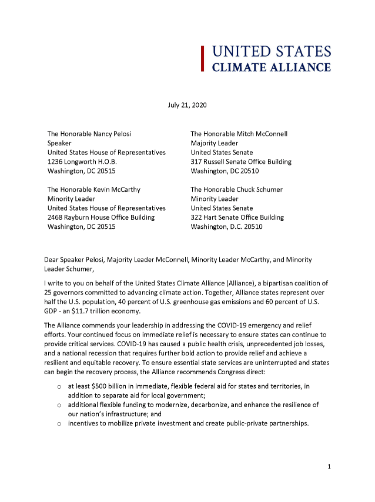Home / U.S. Climate Alliance Outlines Federal Stimulus Recommendations

COVID-19 has caused a public health crisis, unprecedented job losses, and a national recession that requires further bold action to provide relief and achieve a resilient and equitable recovery. The U.S. Climate Alliance has outlined actions that can ensure essential state services are uninterrupted and states can begin the recovery process. Specifically, we recommend that Congress direct:
The current crisis demands a comprehensive, strategic, and equitable response. By preserving core state and local government services, revitalizing our nation’s critical infrastructure, mobilizing private investment, and creating family-sustaining jobs, governors outline how to do this in a way that puts us on a path to economic recovery and addresses the ever-growing climate crisis.
Launched on June 1, 2017 by the governors of Washington, New York, and California to help fill the void left by the previous administration’s decision to withdraw the U.S. from the Paris Agreement, the Alliance has grown to include 24 governors from across the U.S. representing approximately 60% of the U.S. economy and 55% of the U.S. population. Governors in the Alliance have pledged to collectively reduce greenhouse gas emissions by at least 26-28% below 2005 levels by 2025, at least 50-52% below 2005 levels by 2030, and collectively achieve overall net-zero greenhouse gas emissions as soon as practicable, and no later than 2050.
The Alliance’s states and territories continue to demonstrate that climate action goes hand-in-hand with economic growth, job creation, and better public health. While reducing emissions by 18% between 2005 and 2021, Alliance members grew their collective GDP by nearly 30%. The coalition’s states and territories are employing more workers in the clean energy sector, achieving lower levels of dangerous air pollutants, and preparing more effectively for climate impacts and executing more pre-disaster planning than the rest of the country.
###